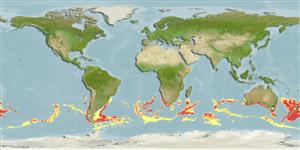>
Lophiiformes (Anglerfishes) >
Ceratiidae (Warty Seadevils)
Etymology: Ceratias: Greek, keras = horn or horned, refers to the lure projecting from the snout (Ref. 86949).
More on author: Norman.
Environment: milieu / climate zone / depth range / distribution range
Ökologie
seewasser bathydemersal; tiefenbereich 100 - 2900 m (Ref. 75154). Deep-water; 26°S - 69°S
Southern Ocean. Also known from Mozambique and South Africa.
Size / Gewicht / Alter
Maturity: Lm ? range ? - ? cm
Max length : 88.0 cm TL (female)
Rückenflossenstacheln (insgesamt) : 1; Rückenflossenweichstrahlen (insgesamt) : 4; Afterflossenstacheln: 0; Afterflossenweichstrahlen: 4. Distinguishing characteristics of metamorphosed female: pair of distal esca appendages; illicium length 19.1 to 28.2% SL; presence of 2-6 vomerine teeth in large specimens; darkly pigmented proximal one-half to two-thirds of escal bulb, oval shaped distal portion, proximal portion tapering into stem of illicium; 2 slender escal appendages arising anterior to escal pore, each appendage nearly always bifurcate, trifurcate or multibranched; escal pore at apex of bulb, raised on pigmented papilla in specimens 75 mm and larger (Ref. 86949).
Majority of collected materials taken by trawls that reaches maximum depth of greater than 650m (Ref. 86949).
Life cycle and mating behavior
Maturities | Fortpflanzung | Spawnings | Egg(s) | Fecundities | Larven
Pietsch, T.W., 1990. Ceratiidae. p. 210-211. In O. Gon and P.C. Heemstra (eds.) Fishes of the Southern Ocean. J.L.B. Smith Institute of Ichthyology, Grahamstown, South Africa. (Ref. 5185)
IUCN Rote Liste Status (Ref. 130435)
Bedrohung für Menschen
Harmless
Nutzung durch Menschen
Fischereien: nicht kommerziell
Tools
Zusatzinformationen
Download XML
Internet Quellen
Estimates based on models
Preferred temperature (Ref.
123201): 2 - 8.4, mean 4.5 °C (based on 779 cells).
Phylogenetic diversity index (Ref.
82804): PD
50 = 0.6875 [Uniqueness, from 0.5 = low to 2.0 = high].
Bayesian length-weight: a=0.01995 (0.00906 - 0.04395), b=3.01 (2.83 - 3.19), in cm total length, based on all LWR estimates for this body shape (Ref.
93245).
Trophic level (Ref.
69278): 3.3 ±0.4 se; based on size and trophs of closest relatives
Fishing Vulnerability (Ref.
59153): High vulnerability (55 of 100).
